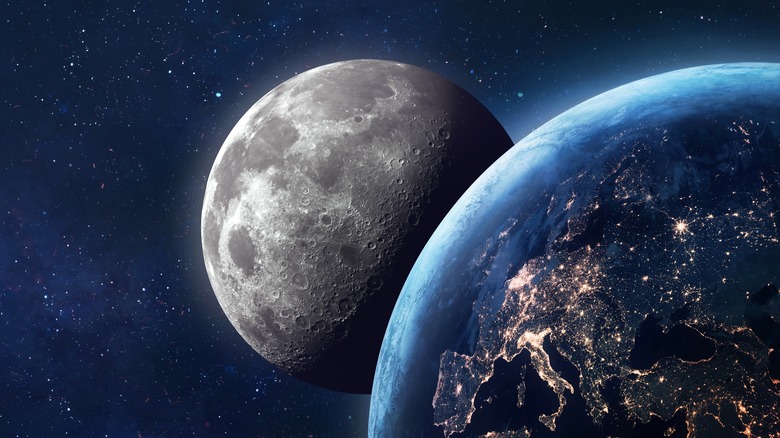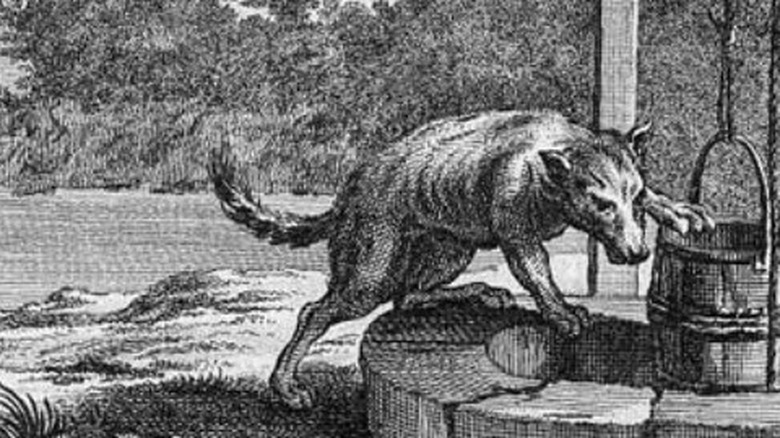Where Did The Myth Of The Moon Being Made Out Of Cheese Come From?
On July 26, 1969, Neil Armstrong set foot on the lunar surface — followed closely by Buzz Aldrin; let's not forget him — and put to rest once and for all one of the most pervasive myths about the moon: that it's made of cheese. It sounds completely ridiculous now — because it is — but it's an idea that has been around a long, long time. So long, according to Eater, it has become a favorite example of unscientific thought.
A writer named G.G. Florine showed this in an issue of a journal called "The Bank Man," which was put out by the Chicago Chapter of the American Institute of Bank Clerks, published in 1915. In it, Florine shows how to counter the argument that the moon is made of cheese because it is round and yellow like cheese. Of course, this is an absurd argument — lots of things can be yellow and round, but aren't made of cheese; yellow Frisbees come to mind — so something having those two characteristics doesn't automatically mean that it's made of cheese.
However, when Florine was writing about this in the early 20th century, everyone knew the moon wasn't actually made of cheese. It was just an extreme example used to illustrate a point. So then where did the myth about the moon being made of cheese come from?
The Moon being made of cheese was first mentioned in a Medieval fable
One of the earliest, if not the earliest, mention of cheese and the moon comes from a fable that circulated during Medieval times. The story goes that a wolf was chasing a fox, hoping to score a quick bite to eat. The fox, which wasn't as fast or as strong as the wolf it was running from, had to save itself with its wits (as foxes often do in this type of story). According to Mental Floss, the fox slammed on the brakes and drew the wolf's attention to a pond, or in other versions of the story, an open well.
The fox tells the wolf to look into the water, where the moon is reflecting off the surface. This distracts the wolf, who instead decides to pursue the cheese instead of the fox. This version of the story originated in Europe, but many other similar stories come from all around the world. One from Africa involves a hyena who drops a bone it was carrying into the water when it sees the moon's reflection and tries to chase after it, while another features a peasant who lets his donkey drink water out of a pond that the moon is reflecting off of. However, a cloud passes in front of the moon, and the peasant panics and kills the donkey because he's scared he just let his donkey drink the moon (via "The Middle English Vox and Wolf," posted at Internet Archive).
John Heywood's greene cheese proverb
Over time the story became not just that the moon was made of cheese, but specifically green cheese. Where this came from is fairly easy to trace. It's included in a collection of proverbs written by Englishman John Heywood, which he published in 1546, per Mental Floss. In it, Heywood writes, "Ye set circumquaques to make me beleue / Or thinke, that the moone is made of gréene chéese" (via Internet Archive). According to Eater, when Heywood wrote the word "greene" to describe the cheese, he wasn't referring to its color. What it meant was a cheese that isn't quite ripe or hasn't been aged very long.
This is often considered the earliest, most direct reference to the moon being made of cheese, and given the popularity of other proverbs that appear in Heywood's collection — including some that are still widely used like "look before you leap" and "I know on which side my bread is buttered" — it's no surprise that it weaseled its way into pop culture through the centuries. The idea of the moon being made of cheese has been featured as a central plot point in cartoons, including a "Tom & Jerry" short and 1989's "Wallace & Grommit: A Grand Day Out."


